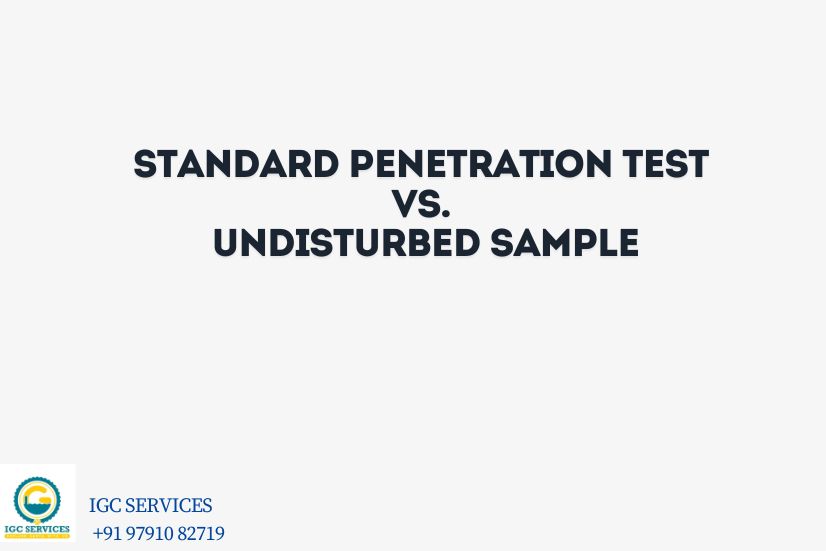
At IGC Services, we specialize in providing reliable and detailed geotechnical investigation services that are essential for informed decision-making in construction and engineering projects. Our expertise lies in quality soil testing and accurate data collection to ensure that our clients have the best foundation for their projects. This blog post explores two fundamental methods in geotechnical investigations: the Standard Penetration Test (SPT) and the Undisturbed Sample method. We’ll break down each technique, examine their importance and advantages, and provide a comparison to help you determine the best approach for your specific needs.
What is the Standard Penetration Test (SPT)?
Definition
The Standard Penetration Test (SPT) is a widely used soil testing technique that helps evaluate soil properties, specifically density and strength. This test is crucial in understanding soil resistance, which can be an indicator of the soil’s stability and load-bearing capacity.
Procedure
The SPT is performed by driving a split-barrel sampler into the ground at the desired depth using a hammer. The number of blows needed to penetrate a standard depth is recorded, which indicates the soil’s resistance to penetration. The collected data is then analyzed to understand the soil’s characteristics, such as density and stiffness, which are essential for making construction and foundation-related decisions.
Data Obtained
The SPT provides valuable information, including soil density and resistance, which allows engineers to classify the soil type and make an informed assessment of its strength and stability.
Importance of Standard Penetration Test
The SPT is essential in geotechnical investigations because it provides a reliable way to measure soil resistance, which can be used to estimate soil density and strength. This information is crucial for determining foundational suitability, particularly for construction projects where soil stability is paramount. Applications of the SPT range from simple site assessments to complex foundation designs, ensuring that structures are built on solid ground.
Advantages of the Standard Penetration Test
- Cost-effectiveness: SPT is a cost-effective soil testing method, making it suitable for various project budgets.
- Simplicity and Ease of Use: The method is straightforward, with relatively simple equipment and procedures.
- Industry Acceptance: The SPT is widely accepted across the geotechnical industry for its reliability.
- Useful for Soil Classification: It provides data that can be used to classify soil types and estimate strength, assisting engineers in understanding subsurface conditions effectively.
What is an Undisturbed Sample?
Definition
An undisturbed sample refers to a soil sample collected in a way that preserves its in-situ structure and properties as accurately as possible. This sampling method is particularly useful for detailed soil analysis and understanding in-situ conditions.
Collection Process
Undisturbed samples are collected using special tools, such as Shelby tubes and piston samplers, which minimize disturbance to the soil. This careful process ensures that the sample retains its original structure, moisture, and density, making it ideal for advanced laboratory testing.
Data Obtained
By preserving in-situ conditions, undisturbed samples provide detailed information about the soil’s structure, composition, and other properties that are crucial for in-depth analysis.
Importance of Undisturbed Samples
Undisturbed samples play an integral role in geotechnical investigations as they allow engineers to conduct a detailed analysis of soil characteristics under controlled laboratory conditions. This testing is essential for applications that require precise information on soil structure, moisture content, and other critical properties. Undisturbed samples are also necessary for evaluating complex soil behavior, which is particularly important for projects with strict engineering requirements.
Advantages of Undisturbed Samples
- Accurate Representation of In-situ Conditions: Undisturbed samples reflect the original structure and properties of the soil, providing a precise representation of the subsurface.
- Ideal for Advanced Laboratory Testing: They are essential for in-depth laboratory tests that require high accuracy.
- Detailed Information on Soil Composition: Undisturbed samples allow engineers to analyze the soil’s internal structure and composition, which can be vital for advanced structural assessments.
Comparison Table: Standard Penetration Test vs. Undisturbed Sample
| Feature | Standard Penetration Test (SPT) | Undisturbed Sample |
|---|---|---|
| Purpose | Soil resistance, density | Accurate in-situ property representation |
| Data Obtained | Soil classification, strength estimation | Detailed soil structure and composition |
| Cost-Effectiveness | High | Moderate to High |
| Application Suitability | Foundation design | Laboratory and structural analysis |
| Industry Acceptance | Widely used | Essential for precise soil analysis |
Conclusion
Both the Standard Penetration Test (SPT) and Undisturbed Sample methods are vital tools in geotechnical investigations, each with its strengths and ideal applications. The SPT is a cost-effective, widely accepted test that provides valuable data for soil classification and strength estimation, making it suitable for most foundational assessments. On the other hand, undisturbed samples offer a high level of accuracy and are essential for advanced laboratory testing where in-depth soil analysis is required.
Choosing the right method depends on the specific requirements of each project. For reliable geotechnical insights and to ensure your project is built on a solid foundation, consider consulting the experts at IGC Services. We are committed to providing quality geotechnical investigation services to meet your needs and ensure successful project outcomes.
